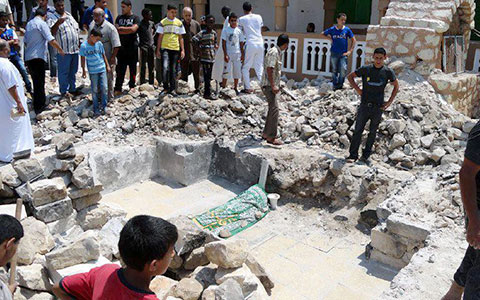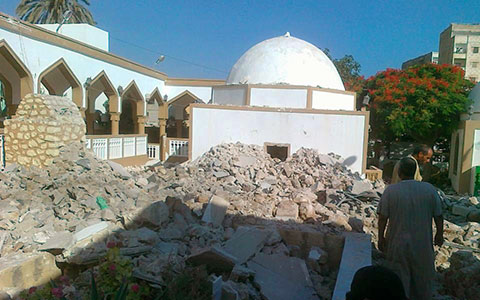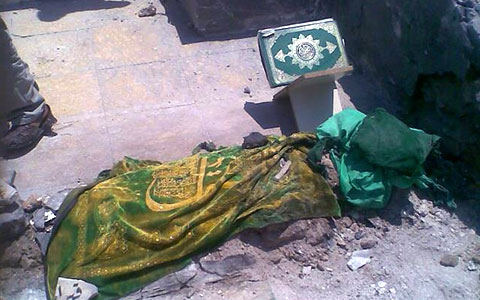Libya: More destruction of Sufi tombs shows Islamists are not defeated
by - 25th July 2012

On Monday, 9 July, Libyan election results showed a major defeat for the Muslim Brotherhood and its local affiliate, the Party of Justice and Construction. The outcome was a surprise to the world after the large votes for Brotherhood parties in Tunisia, Morocco, and Egypt. The more extreme, ultra-fundamentalist Libyan ‘Salafi’ party, Al-Watan (The Nation) – inspired by the ideology of Saudi Wahhabism and led by Abdelhakim Belhadj, former leader of the Al-Qaida-affiliated Libyan Islamic Fighting Group (LIFG) – also fared poorly at the ballot box. The polls in Tripoli, the capital, and Benghazi, the eastern urban centre, were swept by the moderate Alliance of National Forces headed by a political scientist, Mahmoud Jibril.
But Islamists are by no means defeated conclusively in Libya. On the same Monday, around 7.00 a.m., the historic Sahaba Mosque in the eastern Libyan port of Derna was bombed, demolishing the shrine of Zuhayr Ibn Qais Al-Balawi, a seventh-century C.E. companion of Prophet Muhammad and Muslim military leader.
Nobody was injured in the blast, but residents of Derna expressed their anger at the assault. The incident was alarming especially as it coincided with the destruction by the Wahhabi group Ansar Al-Dine (Volunteers of Faith) of historic Sufi shrines at Timbuktu in Mali. The vandalism at the historic sub-Saharan city has elicited global condemnation.

With the fall of Mu’ammar Al-Qadhafi, ‘Salafi’/Wahhabi groups commenced attacking Sufi shrines in Libya, as they did in Egypt after the overthrow of Hosni Mubarak. ‘Salafi’/Wahhabi adherents condemn prayer at graveyards and tombs as alleged idol worship and a supposed dilution of Islamic monotheism.
In October 2011, raids on Libyan Sufi sites included the desecration of the Al-Masry shrine in Tripoli and the extraction from their burial crypts within it of the bodies of two Muslim scholars, Abdul-Rahman al-Masri and Salem Abu Seif. The Sidi Nasr shrine and mosque in Tripoli was similarly damaged in November 2011, again including theft of the remains of distinguished Muslim clerics. In January 2012 fanatics had wrecked the cemetery of Sidi Ubaid in Benghazi, stealing 31 corpses.
The shrine of the fifteenth/sixteenth-century C.E. Sufi Sidi Abdul-Salam Al-Asmar Al-Fituri, at Zliten in western Libya, was targeted four months ago, in March 2012 by one hundred carloads of armed fundamentalists, according to the Libya Herald, a post-revolutionary media source. The Wahhabis in the Zliten episode claimed they were following the guidance of sheikh Muhammad Al-Luhaidan, a prominent Saudi Wahhabi cleric. The Sidi Abdul-Salam Al-Asmar Al-Fituri installation was protected by local inhabitants and armed militia. But at El-Tag near Kufra, in southeast Libya, ’Salafis’/Wahhabi removed the body of Sidi Muhammad Al-Mahdi Es-Senussi (1844-1902), a supreme sheikh of the Senussi Sufi order, from his mausoleum.

Wahhabi agitation in Derna had led the Grand Mufti of Libya, sheikh Al-Sadek Al-Gheriani, to visit the town and deliver sermons at the ’Salafi’/Wahhabi Al-Nur mosque, and at the Sahaba Mosque. In the latter instance, the Grand Mufti sought to convince the Wahhabis that prayer in a mosque sheltering a tomb was not un-Islamic.
The National Transitional Council (NTC) ruling Libya had appealed to Al-Gheriani for a religious opinion on the preservation or destruction of Sufi shrines. He issued three successive and contradictory opinions, the first of which appeared to favour razing the Sufi structures. See footage of the fatwa here. A second argued that such activities were inopportune at the time, and the third definitively banned aggression against shrines.
Even in its ‘Salafi’ camouflage, Wahhabism is unpopular with Libyan Muslims. The latter are devoted to Sufi traditions as a major component of their national history and heritage. Where Muslim clerics and official authorities do not act efficiently to protect the tombs and shrines of Muslim saints, local residents may do so. The Wahhabi minority may harass and interfere with the moderate majority, but there is little probability of a radical victory.
- Log in to post comments
